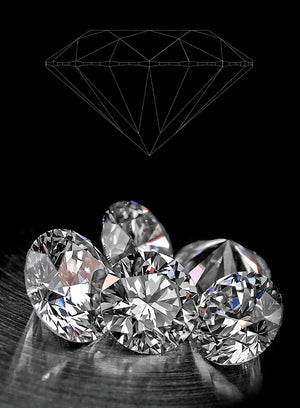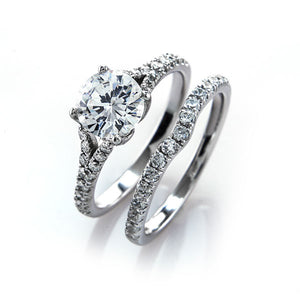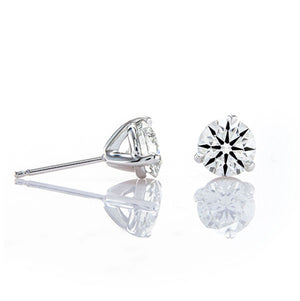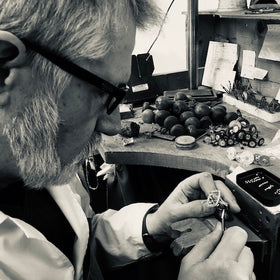
Is Platinum Better than White Gold?
One of the most common questions that we receive from clients is whether platinum is better than white gold, this is usually because they have heard that platinum is more durable than white gold, and because of the perception that platinum must be better than white gold because it tends to cost more.
The reality is that every metal alloy used to manufacture jewelry has its advantages and disadvantages, however most of the time the differences are so minor that the decision to choose platinum or white gold for an engagement ring, should probably come down to a preference over the appearance of the ring.
What is Platinum?
Platinum is a white metal, which was first encountered by the Spaniards in South America in the 16th century, and the name is derived from their word “platina” which literally translates to “little silver” according to Wikipedia.
Platinum is a rare earth metal which is mostly found in South Africa, which accounts for approximately 80% of the annual production of platinum.
Platinum is denser than gold, and therefore if you were to compare this Engraved Cathedral style engagement ring from Brian Gavin, pictured above with optional wedding band, made in platinum, with the exact same ring made in 18k white gold, the platinum version of the ring would feel heavier, and many people equate this heavier feeling being more luxurious.
Another advantage to platinum jewelry is that it is practically made of pure platinum, usually 90 – 95% pure, whereas gold jewelry is almost always alloyed more extensively with 18k gold containing about 75% pure gold.
The fact that most platinum jewelry contains 90 – 95% platinum, as opposed to being alloyed with a higher concentration of other metals such as nickel, zinc, and copper, makes it the perfect choice for anybody who suffers from metal allergies… and this is why many jewelers market platinum jewelry as being hypo-allergenic.
What is White Gold?
While many people seem to think that white gold is an entirely different type of gold from yellow gold, the reality is that white gold is made by combining specific ratios of yellow gold with other metals which make it appear white.
When alloying metals to be used in the fabrication of jewelry, we refer to the different karats of gold, and purities of platinum, in parts per thousand. Thus the gold content of a 14k white gold ring is 585 parts per thousand, or 58.5% pure gold; and the gold content of an 18k white gold ring is 750 parts per thousand, which equates to a gold content of 75%
In the United States, we tend to indicate the gold content of jewelry using karat marks such as 10k, 14k, 18k, 22k, etc., whereas jewelry created in Europe and other parts of the world are more likely to have the gold content indicated in parts per thousand, such as 375 for 9k gold, 585 for 14k gold, and 750 for 18k gold.
Using 18k white gold as an example, a common formula for creating white gold is to combine 75% yellow gold, with 10% palladium, and 10% nickel, with 5% zinc, the last three metals which are white in color, act to turn the yellow gold white and make the resulting gold alloy harder and more durable for use in the making of jewelry.
Can people be allergic to gold?
While pure gold does not oxidize with exposure to oxygen or the chemicals released by our skin, the reality is that the chemicals released by our bodies can react with the other metals commonly used to create gold alloys, and this can create an allergic reaction in some people. The degree of the reaction can vary from the skin exposed to the jewelry turning slightly black or blackish-green, to rashes of different severities; obviously you should remove gold jewelry which causes any sort of significant allergic reaction and try an alternative metal such as platinum, or gold jewelry made of higher karat contents such as 18k.
How is Platinum different than White Gold?
One of the primary benefits of platinum versus white gold in the creation of jewelry is that the higher level of purity used for jewelry making, reduces the oxidation of the ring or jewelry item. Most people with 14k white gold jewelry will notice that their ring essentially yellows over time, what is actually occurring is that the other metals mixed with the gold are oxidizing with exposure to the chemicals released by their skin.
A jeweler can polish the white gold jewelry item to remove the oxidation, but it will return shortly and thus most 10k and 14k white gold jewelry is electroplated with rhodium, which is another white metal that helps to prevent oxidation while the jewelry is being featured in jewelry store display cases.
Unfortunately rhodium plating white gold jewelry is a temporary solution, because the rhodium coating will eventually wear off and then the item will need to be plated with rhodium again in order to provide the same degree of brightness, which results in an additional expense for the person wearing the jewelry.
It should be noted that the higher content of 18k white gold jewelry makes it less necessary for the item to be rhodium plated. Likewise the higher purity of platinum jewelry makes it unnecessary to be rhodium plated at all, and platinum doesn’t really oxidize as much as the metal tends to pick up a slight grey-colored patina, and returns to its original shine and luster with a gentle polishing.
Should you choose White Gold or Platinum?
From the perspective of jewelry fabrication, we tend to think of gold as being softer and more pliable than platinum. The different degree of density and hardness of each of the metals offers different advantages and disadvantages, our jewelers definitely seem to prefer engraving patterns like those pictured on the ring above, on rings made of platinum because the engraving process is easier for them, however they are obviously able to engrave the same pattern on 18k white gold since we offer the ring in that metal choice, as well as 18k yellow gold and rose gold.
From a technical standpoint, white gold is more likely to move if it struck; a white gold prong is more likely to bend to the side if it is struck, whereas the tip of a platinum prong might shear off if subjected to the same degree of pressure and force. But what does this matter in the real world? Either way the prong which holds the gemstone in place is going to be disrupted or the stone might be lost… which is why you should always insure your jewelry against accidental loss, as well as theft or fire.
At the end of the day, both platinum and white gold are excellent options for the fabrication of fine jewelry items, such as diamond engagement rings and wedding bands. Each metal has advantages and disadvantages that go beyond a jeweler’s preference for working with either metal during the jewelry fabrication process, not the least of which is the higher content of platinum in jewelry marked 900, 950 (parts platinum per thousand) or Plat, to be a great option for people who suffer from metal allergies.
















